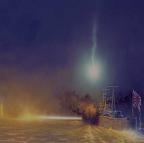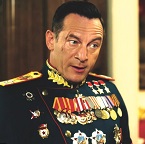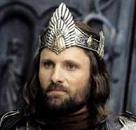kaliyama
Posts: 60
Joined: 7/22/2004
Status: offline

|
quote:
ORIGINAL: Tanaka
quote:
ORIGINAL: kaliyama
quote:
ORIGINAL: Tanaka
quote:
ORIGINAL: Sovyetsky
All the heavy ships could be hanging out next to a rock in the ocean, doesn't mean it's a major supply base.
Truk was THE major supply base for the Japanese Navy in the Pacific. What else do you want? I'm just saying it does not make sense for it to be exactly the same as every other backwater island in the Pacific. Saigon, Bangkok, and Camrahn Bay are all level 8 ports as well.
-------------------------
"It became the Imperial Japanese Navy's Fourth Fleet base from November 1939 and the Combined Japanese Navy Fleet were based there from July 1942 to February 1944. Truk Lagoon was regarded by the USA during World War II as the strongest naval base in the Pacific with the exception of Pearl Harbor. Over 37,000 Japanese lived and worked in Truk Lagoon.
Almost all IJN naval vessels gathered there before making sorties into the Solomons, and returned to Truk for refueling and repair when damaged. Never before had the need for oil storage and repair facilities been more urgent, and the Japanese Navy concentrated its oil tankers and repair ships there while quickly trying to build such facilities on land as well.
During May 1942, the 85th Submarine base, was constructed on the western shore of Dublon Island. It serviced, supplied and did minor repairs to subs. Torpedoes were stored in caves and transported by rail car to the shore. Many different repair and barracks existed specific to submarines.
The South Seas Development Company (Nan’yo Kohatsu K.K) had docking facilities on the southwestern tip of Dublon Island. Its supply storage and fish cannery were commandeered by the IJN and it became the Fourth Naval Dockyard. It was the main receiving area for the military. More warehouses and a refrigeration building, HQ, and a two story barracks were constructed. A thousand men worked here on ship repairs, mostly damage sustained to ships from American submarine attacks. The facility also had a 30 ton floating crane and 2,500 ton dry dock. Nearby was a sawmill and small rail cars connected most of the buildings. The Truk Transportation department loaded and unloaded supplies from ships.
Truk’s facilities included five airstrips, seaplanes bases, a torpedo boat station, submarine repair shops, a communication center, and a radar station. The main radio station of the five in the islands was located at Dublon Island, where several concrete radior receiver shelters and buildings were constructed. The Fourth Harbor Department was located on the southeastern part of the island near Doblon Town. It was 22 wooden buildings including repair shops, warehouses and barracks."
Yes, Truk was a big forward base, but it was still a forward base, and by shipyard standards, a thousand men isn't very much. While you offered a long-ish quote describing the facilities on Truk, the fact that you could spend a paragraph saying what was on Truk does not change the fact that it is at best still a small-medium size port.
You've realy hit two things in your description: (1) it had a big stockpile of supplies, and (2) it was (allegedly) heavily fortified though this proved to be grossly exaggerated in the minds of the allies. In SC2 those factors are reflected in two ways: (1) it should have a decent AA rating if the IJN invests in AA, and (2) it is a secondary supply point.
In terms of actual port facilities and industry, a 2,500-ton dry dock is nothing - Singapore's had two floating dry docks - the smaller of the two came in at like 50,000 tons. Singapore is modeled in game with two level-5 ports.
Truk had to ship all of its raw materials over large distances and a strained IJN shipping network. So what the game is modelling is that forward base dry docks, even very well developed ones, aren't going to be rated as highly as ports with access to the major country's full infrastructure. That Truk is rated the same as Singapore means Truk's value is already inflated in-game.
That is why all of the Australian ports - all of them far larger and better supplied than Truk - are also 5-rated. The impressive thing about Japan's presence there is that Truk, an empty island, is 5-rated to begin with.
You're right that it shouldn't be the seame as Eniwetok, Nauru, Roi-Namur, Kwajelein - in the sense that those places should probably not be secondary supply locations and should have level-3 ports to start. Eniwetok should get bumped up to 5 or 6 if the americans sink MPP into it after capturing it.
Fair enough that is true about Singapore and the other little islands. Are there even level 3 ports in the game? I'm still shocked Mobile, Alabama is not a port! Fun discussion!
quote:
Fair enough that is true about Singapore and the other little islands. Are there even level 3 ports in the game? I'm still shocked Mobile, Alabama is not a port! Fun discussion!
Yes, likewise! It made me get lost in an autistic sea of reading about dry docks. I knew Singapore was touted as a big british military asset but i had no idea how big until you started raising these questions and invited the comparison.
I think the point you were making is that Truk should be more significant strategically in the game than it is currently. I think you are 100% correct there- supply is too trivially easy to obtain in the pacific. If supply was given its proper importance then Truk would be super important as a supply point.
I also wish strategic command modeled experience differently. You look to be a longtime PTO enthusiast (I just started getting into it during quarantine) - I'm sure you know that the usual experience of carriers on deployment was that they'd lose far more aircraft than they would pilots. It's a bit of a klugey abstraction, but you could model this in game by only losing exp on ship repairs and not replacing lost aircraft. Or have a pilot recovery/damage control tech that reduces the amount of exp lost repairing air/ship damage. Thoughts on that?
< Message edited by kaliyama -- 2/3/2021 7:57:19 AM >
|
 Printable Version
Printable Version














 New Messages
New Messages No New Messages
No New Messages Hot Topic w/ New Messages
Hot Topic w/ New Messages Hot Topic w/o New Messages
Hot Topic w/o New Messages Locked w/ New Messages
Locked w/ New Messages Locked w/o New Messages
Locked w/o New Messages Post New Thread
Post New Thread